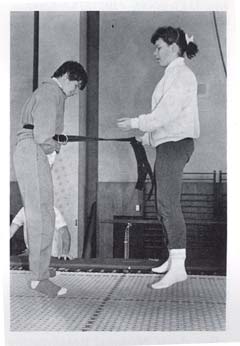

The American Academy of Pediatrics (AAP) discouraged use of trampolines in 1977 with a recommendation (Trampolines, I) that trampolines should be banned in physical education classes and competitive sports programs. The decision by AAP was not based on a high frequency of injuries but was prompted by what was thought to be an usually high number of reported catastrophic spinal cord and neck injuries leading to permanent paralysis. In response to the AAP recommendation, various national organizations interested in preserving the trampoline as a viable instructional aid approved position statements suggesting selective inclusion of the trampoline in physical education classes.
The American Alliance for Health, Physical Education, Recreation, and Dance at its national convention in 1978, adopted guidelines for use of trampolines and minitrampolines in physical education. The guidelines, in the form of a position statement, suggest that trampolines do not constitute an unreasonable risk of serious injury provided that teachers and spotters utilize appropriate instruction and supervision strategies. AAP modified its ban on trampoline use in 1981 by releasing a second position statement (Trampolines II) which did not fully endorse the use of trampolines but suggested a trial period of limited and controlled use by schools while the Association more fully assessed the incidence, severity, and cause of injuries.
Despite these latter position statements, AAP's initial 1977 ban greatly diminished use and, in many cases, prevented utilization of the trampoline for instructional purposes. Shortly after 1977, many school committees directed their physical education departments to sell their trampolines; others had them permanently locked away. Insurance underwriters, not willing to assume risk, frequently wrote policies with exclusionary clauses.
The trampoline tends to ameliorate the development of specific perceptual motor and locomotor skills more than most other products on the market today; some professionals consider the trampoline an essential aid for teaching directionality - the development of kinesthetic and vestibular discrimination. Children not proficient at jumping often lag behind in development of hopping, skipping, and motor skills which are basic to sport proficiency. Such children and children who are earth bound (unable to jump) tend to be highly motivated when placed on the flexible trampoline surface. Jumping skills for these children are often extremely difficult to teach without use of a trampoline.
A proactive strategy which addresses the educational value and employs strict teaching and spotting procedures to minimize the risk of injury, may help to persuade school boards to reinstate the trampoline and insurance underwriters to renew coverage. When developing directionality and jumping skills on the trampoline, instruction does not constitute taking unreasonable risks. Directionality and jumping skills necessitate use of only the most elementary movements on the trampoline, namely: straight bouncing, 900 turns, seat drop, and knee drop. On the other hand, teachers may want to avoid the potentially dangerous somersault, as well as some intermediate skills, i.e., the front and back drop.
In addition to limiting trampoline use to only those skills which facilitate development ofdirectionality and jumping, other factors should be taken into consideration when developing an effective risk management program. These include: